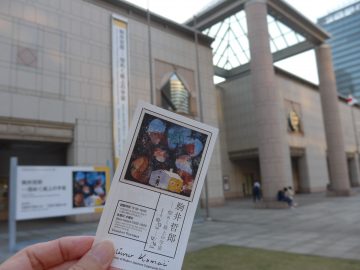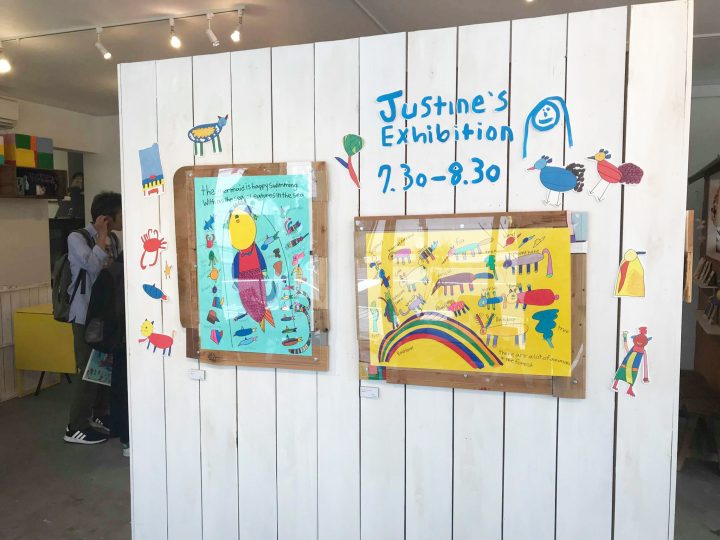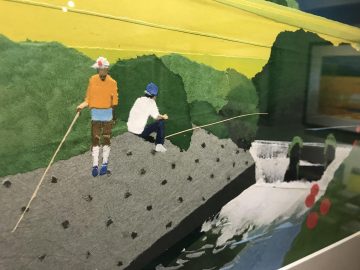“Miura People Exhibition” recreates a German project from 100 years ago

Expressing the town of Miura in a portrait
--Mr. Aritaka recently moved to Zushi, and Mr. Kuwamura to Miura.
Aritaka : I have lived in Tokyo for over 20 years, and I often come to Zushi for filming and other purposes, but I happened to find a house that I liked, so I moved there four years ago. At first, it was quite difficult to go to Tokyo, but the train is convenient and I'm gradually getting used to it.
Osamu Kuwamura : I'm from the Kansai region and have lived in Tokyo all my life. I worked as an editor for a music magazine, and had monthly deadlines that required me to spend the night at the office, so I moved to Miura because I wanted to relax in my private life.
Osamu Kuwamura : Miura is a very attractive city with thriving agriculture and fishing industries, delicious food, and an abundance of nature. From our point of view as immigrants, there are many local people who love Miura, but we wanted to do an ``artistic project'' that would allow young people to rediscover the ``charm of the area.'' A few years ago, we released an app to introduce vegetable stands on the Miura Peninsula, and while we were creating it, we visited each farmer to gather content. Through these activities, I have deepened my relationships with local people, learned about the problems faced by the local community, and come to feel that way.
Aritaka : I also connected with people in Miura related to food and participated in the activities of the Shokusai Network, and there were a lot of interesting people there, so I started photographing farmers and fishermen as part of my own work. .
Osamu Kuwamura : I knew that Mr. Aritaka took such photos, so we had been talking about wanting to make something out of them for a while. At the right time, we received an offer from Kanto Gakuin University, which had been selected for the Agency for Cultural Affairs' ``University-Utilized Cultural Arts Promotion Project,'' to submit a project through SaMAL, which connects art projects in Sagami Bay and the Miura Peninsula. We have started planning in earnest.
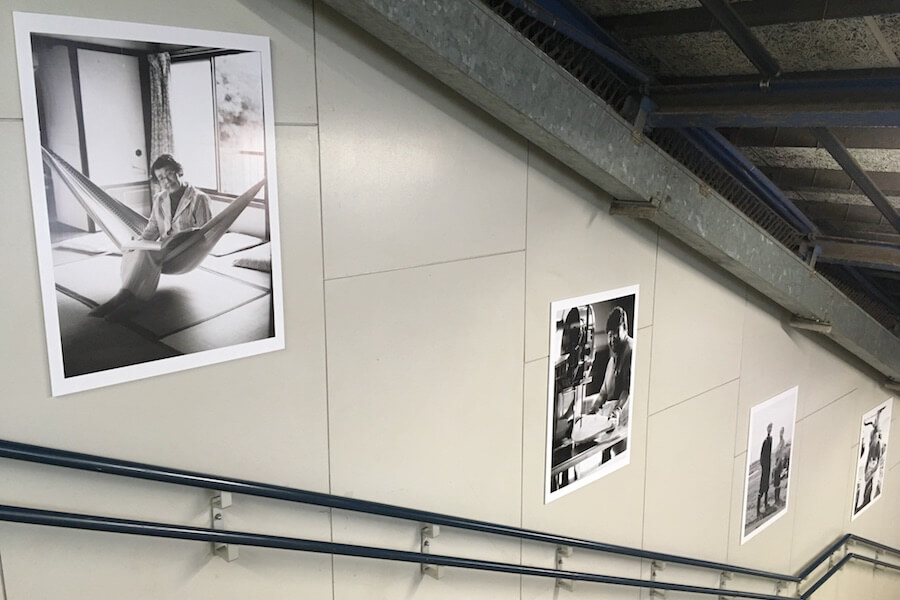
Exhibition at Misakiguchi Station
--Are the works on display different from the ones you've been photographing?
Aritaka : This time, all of the photos were taken specifically for the photo exhibition.
Osamu Kuwamura : There was a photographer named August Sander who was active about 100 years ago, and he created portraits of people living in the Rhine region of Germany, such as farmers, bricklayers, and cooks, to represent an era. You were working on a project. I think it would be a little difficult to do that in Tokyo or Yokohama, for example. People who work in cities usually wear suits, so it's hard to tell what they're doing by looking at their shape or texture. However, since Miura has many primary industries, we thought that projects that were established in Germany 100 years ago could still be done in Miura, so we planned this project.
Aritaka : When I heard from Mr. Kuwamura about the concept of Xander, I was convinced that Miura would be able to shoot from this perspective.
“The people of Miura” as seen by local residents
--How did you choose your subjects?
Aritaka : I'm from Zushi and don't know all the people in Miura, so I asked Kuwamura and others to recommend a number of people to me, as well as the members of the executive committee.
Osamu Kuwamura : I've only lived in Miura for about five years, so I didn't have any connections with people who had been here for a long time. To carry out this project, we assembled an executive committee of people who were born and raised in Miura as well as young people. So we had a lot of discussions about what kind of person we should photograph to express Miura.
During those discussions, we came up with the idea of choosing, for example, a doctor who has been in charge of school health checkups as the subject. He is 87 years old and has been a doctor in Miura for 50 years. Many people who grew up in Miura know this. But people like us who came from outside don't know that such people exist. The fact that we were able to photograph such a presence was the result of discussions at the executive committee.
By the way, the doctor specializes in dermatology and urology, and he knew a lot about the history of the Miura men, and I was able to hear his valuable stories.
Aritaka : Something like a story from the Showa era when it was hot.
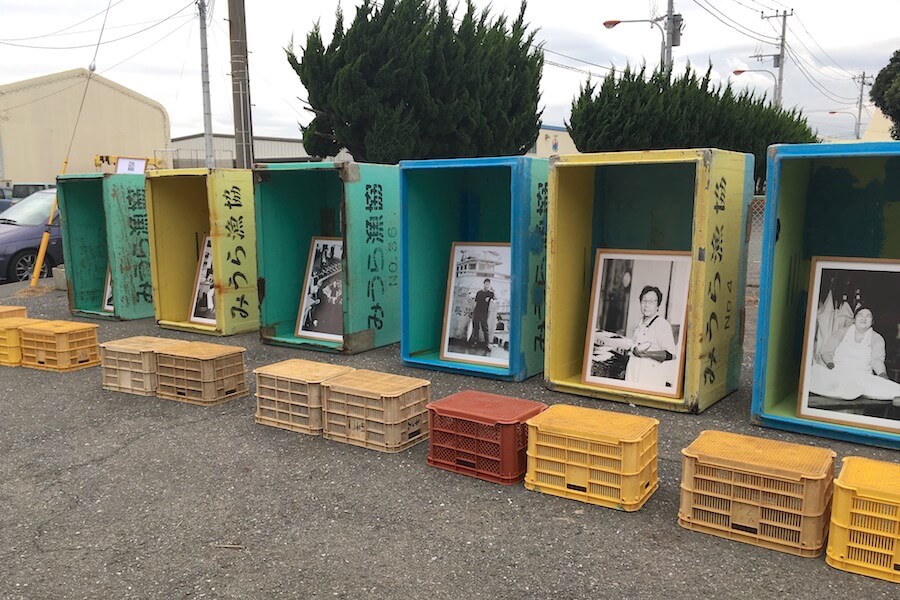
Exhibition at Misaki Port venue
Osamu Kuwamura : During the Showa era, Miura was a prosperous area known for its tuna fisheries and was a busy downtown area with several movie theaters. In such places, fishermen who have been out fishing in the deep sea come back to the port and have fun. I've heard many stories like that (lol).
Regarding the selection of subjects, I think it was important for us to discuss this with people who were born and raised in Miura for this exhibition.
--What kind of people were on the executive committee?
Osamu Kuwamura : There are young farmers in their 20s and 30s, wallpaper shops, seed shops, donut shops, noodle makers, civil servants, and even video creators.
Osamu Kuwamura : Not all of us are necessarily creators, but there are many people who were born and raised in the area, and many of whom I met through the ``Town Project Planning Course,'' which I held twice in Miura to think about art projects. hey.
Aritaka : The executive committee for the photo exhibition includes farmers and noodle makers, and although there is no connection between their work and photography, it's interesting that everyone is working together to create it.
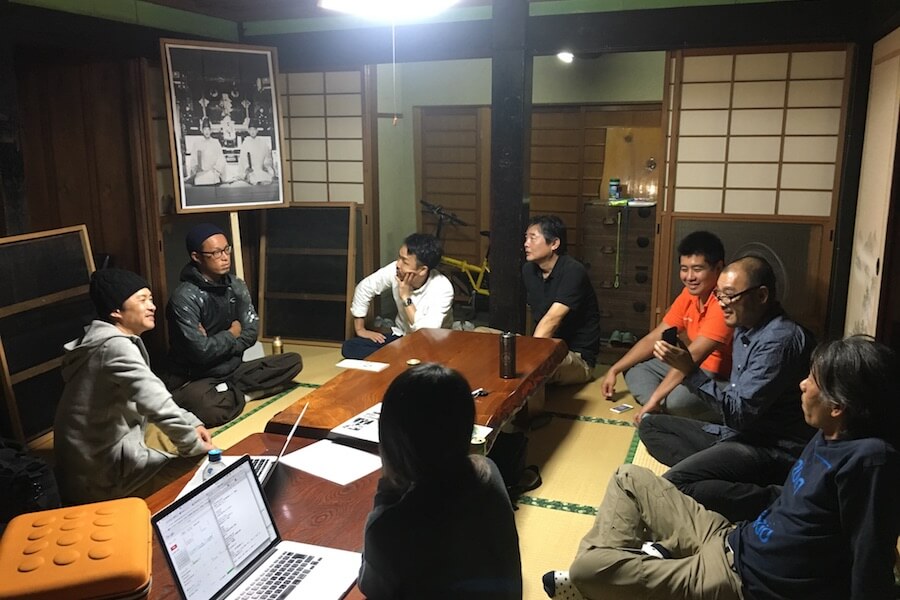
Executive committee members
Osamu Kuwamura : In preparation for the ``Miura People Exhibition,'' we held two events called ``Thinking in Miura! Town Project Planning Course'' to think about how to hold an art event in the city of Miura. It was. This is a two-part event, and the first part will involve members of the executive committees of ``Manazuru Machinare'' and ``Hayama Art Festival'' to talk about what it means to hold an art event in the community. I heard. In the second part, we had a discussion with the participants about ``What kind of art events could be held in Miura?'' People who actively gave their opinions during this event are also on the executive committee. I don't think art is something that is too difficult to understand, and I think it's okay to start with the idea of simply doing something interesting. This event was an opportunity to open the door for people to feel free to participate in the Miura People Exhibition.
Osamu Kuwamura : I want to do something here to solve the problems that Miura faces, such as population decline, increase in vacant houses, and infrastructure! I realized that there were quite a lot of young people who thought so, and high school students also came.
“One-on-one competition” with the subject
--Did you get the cooperation of everyone in the town smoothly?
Aritaka : Since this was my first attempt, I explained everything in detail and carefully. There were so many things that I could talk about.
Osamu Kuwamura : None of the subjects were shy.
Aritaka : The shooting style was not for me to follow the person, but for them to set up a tripod and step into the frame of the camera. Because of that style, no one was too intimidated, everyone was prepared, and it felt like a one-on-one battle.
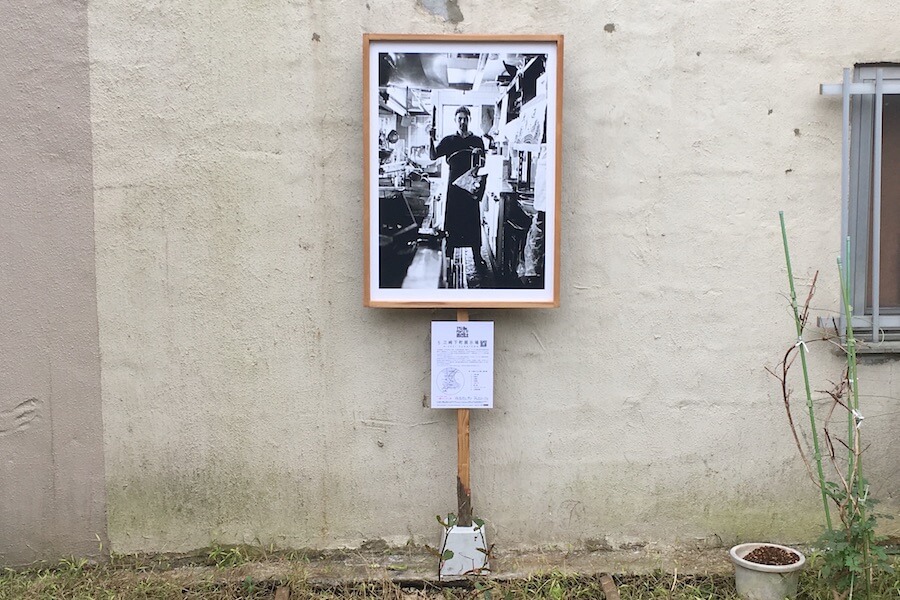
Exhibition at Misaki Shitamachi venue
Osamu Kuwamura : However, some of the subjects asked me, ``Should I smile?'' But instead, I asked them, ``Please don't laugh.'' Even in the filming of the ``Miura People Exhibition,'' I was also involved in some directing work. But I didn't want her to have a fake smile. I do stage things to express the subject, but there is no need for fake smiles or lies. That's the part I paid a lot of attention to.
Aritaka : At first, I told him a lot not to laugh.
Osamu Kuwamura : I want you to add parentheses. We also think it's cool. However, I don't usually smile when I work. Of course, there are jobs like that. That's why I thought it was natural.
Aritaka : If it ends up like that, I'll end up being photographed, so it won't turn into a work. That wouldn't be fun to continue with, so I tried my best to somehow maintain this style. I shoot with almost the same fixed focal length lens. From the beginning, I had the theme of photographing people from all walks of life from the same perspective and from the same distance, so I didn't have to worry about it too much.
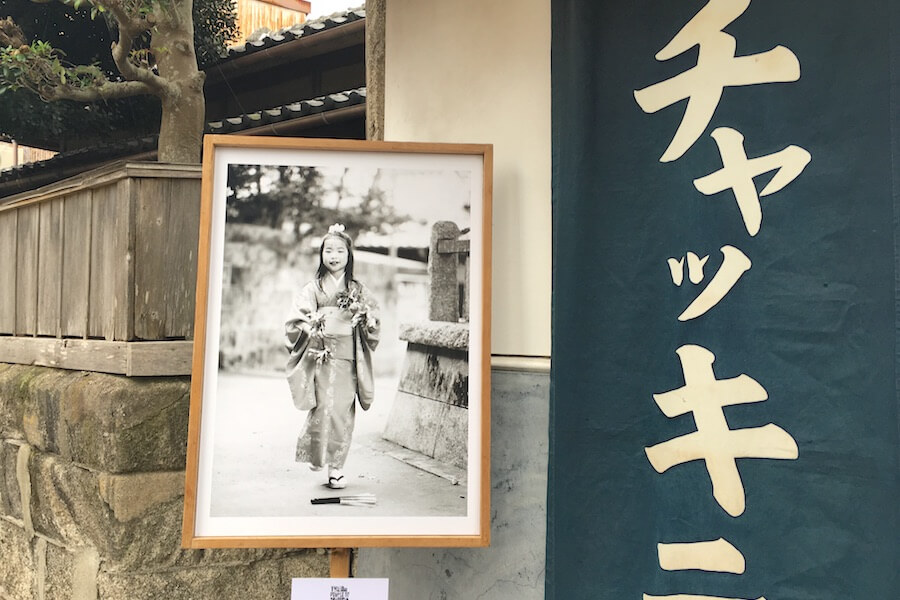
Exhibition at Misaki Shitamachi venue
Osamu Kuwamura : When shooting, deciding where to shoot was also a very important factor. When I photographed the fishermen fishing for whitebait, we gathered together at 5 a.m., got on the boat together, accompanied them on the whitebait hunt, and returned home after fishing for about four hours. I couldn't sail without Shirasu, so I rescheduled about three times before I was finally able to accompany him. Some photos took a long time to take, while others took just 5 minutes. For the waitress girl at the coffee shop, I quickly negotiated and photographed her on the spot.
During the shooting, I also filmed a video interview with the subject. In the exhibition hall, we will not only show photos but also introduce videos of the stories of the subjects.
A timeless landscape
--Was it decided from the beginning that it would be monochrome?
Aritaka : Kuwamura-kun told me that he wanted to do an exhibition at the fish market, and when I went to see the scene, I thought that if it was a big, rugged box, monochrome would definitely be cooler.
Osamu Kuwamura : I thought that by shooting in black and white, I could transcend time. Colors can always give a sense of the times. The idea was that by using black and white, it would be possible to make Zander's photographs from 100 years ago and modern photographs look contemporary. I think using a fish market as an art gallery is an unprecedented attempt. It's a very special place, so I think this will be a photo exhibition unlike anything you've seen before. This fish market has a total length of about 100m. For example, in Tokyo, there aren't many passages where you can walk straight for 100 meters. We are thinking of an exhibition that effectively uses the straight aisles of this market. Since it is a large venue, we will exhibit works that are commensurate with its scale. I would be happy if people who like photography and art would come.
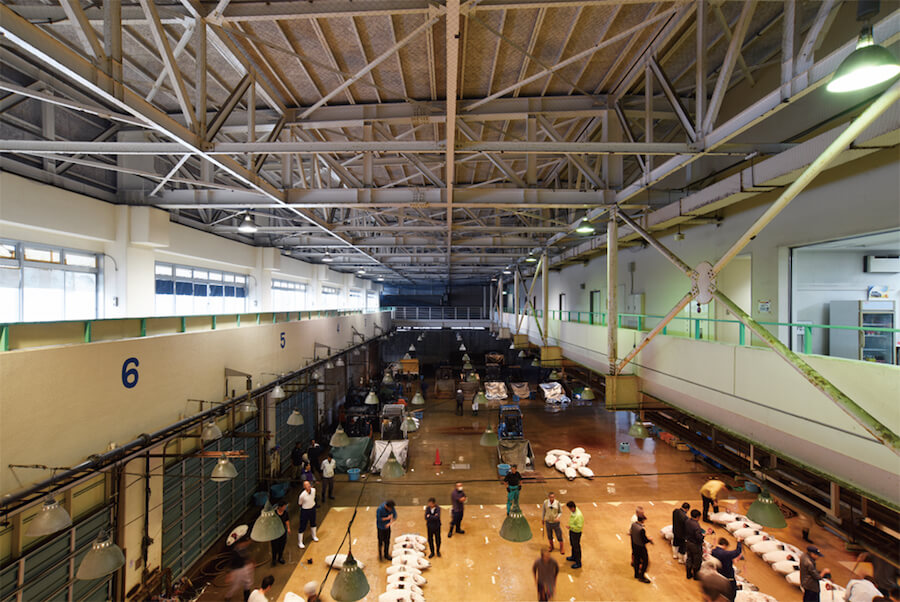
Misaki Fisheries Regional Wholesale Market
--What kind of activities do you have planned for the future?
Osamu Kuwamura : Miura is a very photogenic town. Apparently there was a photo session in Misaki during the first exhibition, and about 250 amateur photographers from all over the Kanto region came. The old townscape of Misaki still remains, with remnants of the Showa era. The people who live there are also included in the pictures. There's something about the cityscape and people that makes people who love photography want to take pictures.
Aritaka : That was the first reason I started going to Misaki often. There are a lot of things like this left in back alleys. There's something nostalgic about the flow of air, and it makes me want to go there with my camera in hand.
Osamu Kuwamura : The theme of the ``Miura People Exhibition'' was to express the city through portraits. I think it might be possible to do a project related to photography from a different perspective.
The members of this year's executive committee include people who like music, so I think we can hold an art event that is different from photography. I would like to create opportunities to express art and culture in the Miura area.
